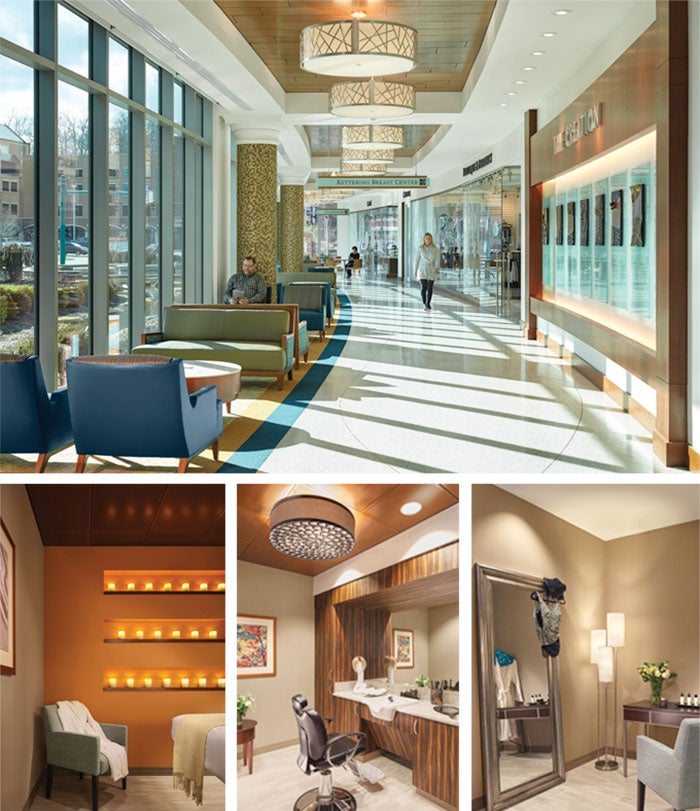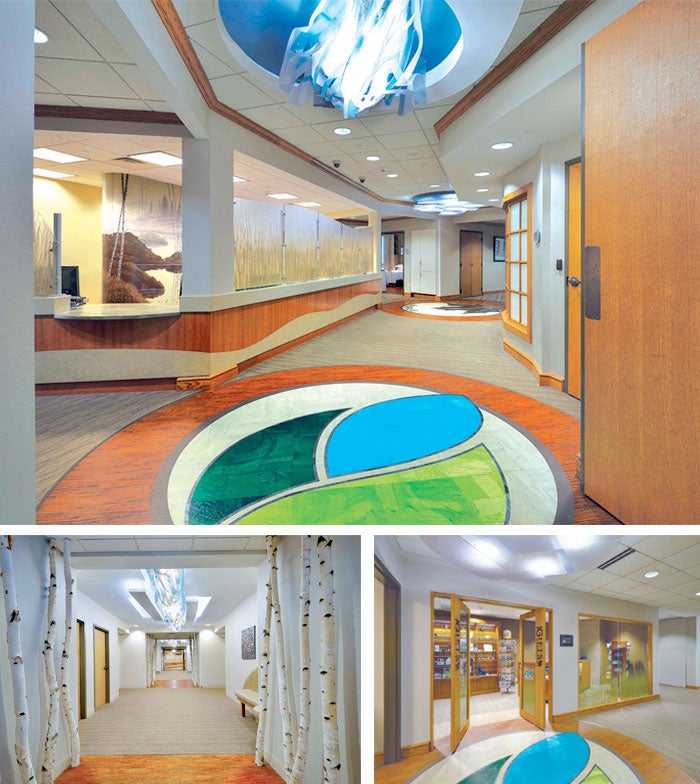Health care facilities go for high-end design in retail spaces

The Walgreens pharmacy on the second floor of Northwestern Medicine's Lavin Family Pavilion is the retaile's first location in downtown Chicago to offer such equipment, according to the health system.
Health care organizations are catering to an increasingly consumerist patient population with retail spaces designed to delight, comfort and simplify people’s lives, and to improve their health.
Added benefit
“Health facilities look at retail as a way of providing an additional level of convenience and service for their patient population,” says Jocelyn Stroupe, CHID, EDAC, IIDA, ASID, director of health care interiors for CannonDesign, Chicago. “Facilities want to try to capture as much of a patient’s attention as they can.”
By building a one-stop shop for health care and related merchandise, hospitals and health systems can provide an added benefit to their community. “Most of us, as consumers, want things to be easy to find and convenient,” says Stroupe. “Whenever you’re dealing with a health care situation, whether you’re a patient or a visitor, it’s an intrusion on your daily life.” Providing needed items for sale at a health facility draws people in and helps to create a positive experience.
Health care organizations are expanding beyond the traditional gift shop in the design of retail spaces. As providers embrace a health and wellness model of care, health facility retail products may include athletic apparel and accessories or health education materials like cookbooks with healthy recipes. Some facilities have outlets for durable medical equipment. The Walgreens pharmacy on the second floor of Northwestern Medicine’s Lavin Family Pavilion is the retailer’s first location in downtown Chicago to offer such equipment, according to the health system.
Other health facility shops are designed to appeal to a certain demographic, such as women or children. For patients whose conditions require items that may prove difficult for them to find on their own, specialty care boutiques are helpful. Oncology centers often have specialists on staff to curate merchandise like wigs or prosthetics, and who can help with fitting these items. “It’s a huge satisfier for patients,” says Stroupe.

The gift shop at Children’s Mercy Adele Hall Campus, Kansas City, Mo., was designed to be vibrant, playful and dynamic, with a ceiling made of 60 suspended panels in a wavelike pattern illuminated by a programmable LED lighting system and interactive videos projected onto the flooring that can create the illusion of kicking a ball or stomping in a puddle.
Renew Boutique and Spa at Kettering (Ohio) Cancer Center provides this type of service. The cancer center is located on the campus of Kettering Medical Center, which was named among the 20 most beautiful hospitals in America by health care staffing company Soliant Health, Atlanta, on its annual list this year. In the design of the boutique and spa, a conscious effort was made to create an upscale environment for patients, says Stroupe. The space, which features floor-to-ceiling windows, natural wood tones and a soothing color scheme, is intended to inspire and comfort.
The gift shop at Hospice of Dayton (Ohio) incorporates natural-look elements, as well. As architect David B. Bills, AIA, LEED AP B+C, Brown & Bills Architects Inc., Englewood, Ohio, explains, the hospice facility is located on 17 acres of wooded land, but many of the residents are immunocompromised and cannot go outdoors. Brown & Bills Architects and Designworks Studio, Maineville, Ohio, recently refreshed the hospice design using materials throughout the facility that bring the outdoors in, in a manner consistent with infection prevention and control standards.
The gift shop design features pressed glass panels with an interlayer of natural bear grass by 3form, Salt Lake City; carpet by Atlas Carpet Mills, Los Angeles, that has a wavy pattern evocative of a flowing river; wood-look resilient tile by Tandus Centiva, Dalton, Ga., and wooden display furnishings by Newood Manufacturing Inc., Eugene, Ore.
Translucent resin ceiling panels, also by 3form, create a cloud effect at the entrance to the gift shop, similar to that of a nearby chandelier by LightArt, a 3form company based in Seattle. The flooring at the entrance to the gift shop is inlaid with the Hospice of Dayton logo, a leaf design. The striking design of the shop allows it to serve as both an amenity and a wayfinding cue at the facility.

Renew Boutique and Spa at Kettering (Ohio) Cancer Center features floor-to-ceiling windows, natural wood tones and a soothing color scheme with amenities designed to create an upscale environment that inspires and comforts patients.
Dynamic design
The gift shop at Children’s Mercy Adele Hall campus in Kansas City, Mo., functions as an eye-catching amenity, too. According to Rich Majors, AIA, chief operating officer and executive vice president, BRR Architecture Inc., Merriam, Kan., a hospital renovation project provided an opportunity to expand the square footage allotted to the gift shop and give it a vivid redesign. “The hospital had several donors who wanted to create a more inviting space,” says Majors.
The designers wanted to craft a place that would appeal to a wide range of people: younger and older patients, their siblings and parents, other visitors and staff members. “The staff that we worked with were very passionate about this from a design standpoint and [wanted] to be able to serve their customers,” says Majors. “The staff were excited to have a space big enough, and a budget to do something unique and powerful.”
The design goals were to make the gift shop vibrant, playful and dynamic. The project team reimagined the columns of the existing structure as pebbles arching into still water. “We used that idea to start to create some ripples in the ceiling,” Majors says.
A suspended system of more than 60 fins forms a wavelike ceiling pattern that is illuminated by customizable LED lighting. The colors can be changed in celebration of a holiday, such as red and pink for Valentine’s Day, or to recognize the change of seasons, such as yellow and orange for fall. The lighting can be static or programmed to make the ceiling appear to move. Audio effects strengthen the impact of the design. “Through lighting and sound, you can imagine it as under the sea, in a cave, out in space or in a forest canopy,” says Majors. “Every day it’s different.”

Materials and designs used throughout Hospice of Dayton (Ohio) are meant to bring the outdoors inside, including pressed glass panels interlaid with natural bear grass, translucent ceiling panels that are reminiscent of clouds and a floor inlay of the hospice logo, a leaf design.
Interactive videos projected onto the flooring create the illusion of kicking a ball across the floor or stomping a puddle.
The ever-changing design draws people’s attention and creates a sense of awe. “You can see it on the faces of people,” Majors says. “Just the joy and wonder as people look up at that ceiling.”
‘A win for everybody’
“No one wants to be in a hospital,” Majors says. Giving people a little bit of joy while they’re at the facility, and giving staff an enjoyable and lively work environment made the Children’s Mercy project “a win for everybody,” he says. Retail spaces that distract and amuse, comfort and soothe, make patients’ busy lives easier or support them in living a healthy lifestyle are a winning proposition.
Amy Eagle is a freelance journalist based in Homewood, Ill., who specializes in health care-related topics. She is a regular contributor to Health Facilities Management.




